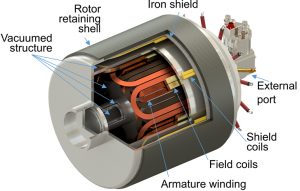Superconducting Machine for Hydrogen-Powered Electric Aircraft Propulsion
PhD student Thanatheepan Balachandran with advisor K. Haran
The Center for Cryogenic High-Efficiency Electrical Technologies for Aircraft is a NASA-funded project aimed to design an ultra-efficient electrical system with the high specific power required for commercial electric aircraft. To achieve this goal, a cryogenic hydrogen-energy electric aircraft is proposed to utilize the high specific energy content of liquid hydrogen (LH2) through fuel-cell energy conversion and an ultra-efficient distributed electric propulsion. The concept employs LH2 both as an energy storage mechanism and a cryogen to enable a highly efficient superconducting (SC) electric system. This allows operating SC machines with SC power cables to efficiently convert electrical energy into mechanical energy. Letting gaseous hydrogen used in the fuel cells evaporate by heat losses in the SC motor and cables, the system provides free cryogenic cooling for SC electrical components. If the required cryogenic power to remove generated heat losses in the electrical system is maintained below the available free cooling, an ultra-efficient electrical system could be obtained.
Operating the electrical system under the cryogenic system also provides various advantages, including the low resistivity of “conventional” conductors like copper or aluminum. This project considers a 40 MW regional airplane operating for six hours and analyzes the feasibility of three motor topologies for its electric propulsion: (1) fully SC machine with active shield and iron shield configuration, (2) partially SC machine with active shield and iron shield configuration, and (3) permanent magnet machine with SC armature coils and cryo-cooled conventional conductors. Pros and cons of each topology are analyzed, and the optimal motor topology for commercial electric aircraft identified. Each motor is optimized to maximize its efficiency and specific power. Figure 1 shows that the preliminary mechanical design of an optimal motor with a power density greater than 25kg/kW could be achieved with an allowable cooling budget of 5kW.
Although fully SC machines look attractive for electric propulsion, they have significant practical challenges. Therefore, various experiments will be performed to validate the machine components.
